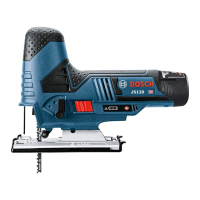-12-
Footplate angle adjustment
The footplate may be tilted to allow
angle cuts up to 45° in either direction
(Fig. 7).
Note: before adjusting the footplate,
remove anti-splinter insert if used.
To adjust footplate, loosen the footplate
screw with 5mm hex key and slide the
footplate towards the back of tool, then
rotate to desired angle (Fig. 7).
The detent slots will hold the footplate
firmly at 0° or 45°, and there are
additional position marks for 15°, 22.5°
and 30° angles. Intermediate angles may
be set with a protractor (Fig. 7).
After positioning the footplate, securely
tighten the footplate screw (Fig. 7).
Tool Tips
Always hold the saw
by the insulated
gripping surfaces on the front of the
tool and the switch handle. Failure to
hold the tool by the insulated gripping
surface may result in electric shock or
electrocution if sawing into a blind area
where live wiring exits.
Always be certain that smaller
workpieces are securely fastened to a
bench or other support. Larger panels
may be held in place by clamps on a
bench or sawhorses.
To begin a cut, clearly mark the cutting
line, and rest the front of the footplate
on the work. Engage the switch, and
move the blade into the work using only
enough forward pressure to keep the
blade cutting steadily. Do not force, as
this will not make the saw cut faster; let
the blade do the work.
When sawing metal or similar materials,
apply coolant/lubricant alongside the
cutting line.
Use of reverse-tooth blade such as the
Bosch T101BR requires the orbital
setting to be “0” and that downward
pressure be applied to the top of the
saw.
Blade Selection
• Choose blades carefully, as the ability of
the jig saw to make the fastest cuts, to
follow tight curves, to achieve the
smoothest finish and/or to maximize the
life of the blade are directly related to the
type of blade used.
• Always use a blade that is appropriate for
the cutting task.
• Always make a test cut in a piece of scrap
material.
• For tight curves it is best to use a
narrow (front to back) or scroll blade.
• Most jig saw blades have upward-pointing
teeth, which helps to pull the jig saw
against the workpiece and minimizes
vibration. Blades with upward-pointing
teeth produce a clean cut on the bottom
of the workpiece.
• Blades with downward-pointing teeth
(reverse-tooth blade) can be used to
produce a clean cut on the top of the
workpiece (that side that faces the jig
saw's footplate), such as when cutting an
already-installed countertop from the top.
When using reverse-tooth blades,
downward force must be applied to the
jig saw.
• Blades with teeth that point straight out
(rather than up or down) allow splinter-
free cutting on both sides of the
workpiece. When using such blades,
downward force must be applied to the
jig saw.
• The following types of blades should only
be used with orbital Setting O:
1. Blades with teeth that point
downward (reverse-tooth blades).
2. Blades with teeth that point straight
out rather than up or down.
3. Carbide-tipped blades.
4. Grit-edge blades.
FOOTPLATE
SCREW
FIG. 7
BEVEL
SCALE
FOOTPLATE
Operating Instructions

